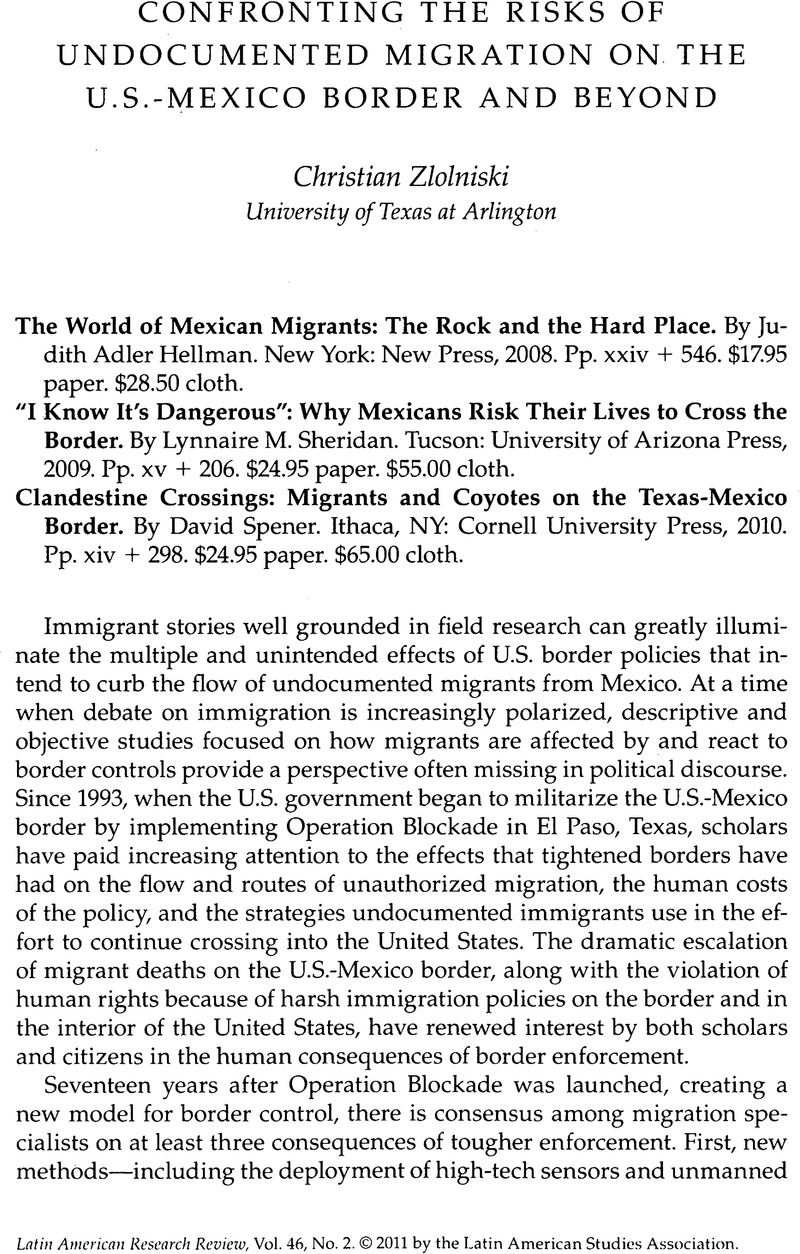Published online by Cambridge University Press: 05 September 2022

1. See Wayne A. Cornelius and Jessa M. Lewis, eds., Impacts of Border Enforcement on Mexican Migration: The View from Sending Communities (Boulder, CO: Lynne Rienner Publishers, 2006); Pia M. Orrenius, “The Effects of U.S. Border Enforcement on the Crossing Behavior of Mexican Migrants,” in Crossing the Border: Research from the Mexican Migration Project, ed. Jorge Durand and Douglas S. Massey (New York: Russell Sage Foundation, 2004); Wayne A. Cornelius, “Death at the Border: Efficacy and Unintended Consequences of U.S. Immigration Control Policy,” Population and Development Review 27, no. 4 (2001): 661-685; Timothy Dunn, Blockading the Border and Human Rights: The El Paso Operation That Remade Immigration Enforcement (Austin: University of Texas Press, 2009); Jonathan Hicken, Mollie Cohen, and Jorge Narvaez, “Double Jeopardy: How U.S. Enforcement Policies Shape Tunkaseño Migration,” in Mexican Migration and the U.S. Economic Crisis: A Transnational Perspective, ed. Wayne A. Cornelius, David Fitzgerald, Pedro Lewin Fisher, and Leah Muse-Orlinoff (La Jolla: Center for Comparative Immigration Studies, University of California, San Diego, 2010), 47-94; Guillermo Alonso Meneses “Los peligros del desierto en la migración clandestina por California y Arizona,” in Antropología del desierto: Paisaje, naturaleza y sociedad, ed. Rafael Pérez-Taylor, Miguel Olmos Aguilera, and Hernán Salas Quintanal (Mexico City: Universidad Nacional Autónoma de México and El Colegio de la Frontera Norte, 2007), 109–120.
2. D. S. Massey, J. Durand, and N. Malone, Beyond Smoke and Mirrors: Mexican Immigration in an Era of Economic Integration (New York: Russell Sage Foundation, 2003).
3. Marcelo M. Suárez-Orozco, “Right Moves? Immigration, Globalization, Utopia, and Dystopia,” in American Arrivals: Anthropology Engages the New Immigration, ed. Nancy Foner (Santa Fe, NM: School of American Research Press, 2003), 57.
4. Leo Chavez, The Latino Threat: Constructing Immigrants, Citizens, and the Nation (Stanford, CA: Stanford University Press, 2008).
5. Nicholas De Genova, Working the Boundaries: Race, Space, and “Illegality” in Mexican Chicago (Durham, NC: Duke University Press, 2005); Josiah Heyman, ed., States and Illegal Practices (Oxford: Berg Publishers, 1999); Josiah Heyman, “Why Interdiction: Immigration Control at the United States-Mexican Border,” Regional Studies 33, no. 7 (1999): 619-630; Mae M. Ngai, Impossible Subjects: Illegal Aliens and the Making of Modern America (Princeton, NJ: Princeton University Press, 2004).
6. Suárez-Orozco, “Right Moves?” 46.
7. Pierrete Hondagneu-Sotelo, Gendered Transitions: Mexican Experiences of Immigration (Berkeley: University of California Press, 1994); Patricia R. Pessar, “Engendering Migration Studies: The Case of New Immigrants in the United States,” American Behavioral Scientist 42, no. 4 (1999): 577-600; Cecilia Menjívar, “The Intersection of Work and Gender: Central American Immigrant Women and Employment in California,” American Behavioral Scientist 42, no. 4 (1999): 601–627.
8. Douglas S. Massey, Rafael Alarcón, Jorge Durand, and Humberto González, Return to Aztlán: The Social Process of International Migration from Western Mexico (Berkeley: University of California Press, 1987).
9. Massey, Durand, and Malone, Beyond Smoke and Mirrors, 164.
10. See Pierrete Hondagneu-Sotelo, God's Heart Has No Borders: How Religious Activists Are Working for Immigrant Rights (Berkeley: University of California Press, 2008); Jacqueline M. Hagan, “The Church vs. the State: Borders, Migrants, and Human Rights,” in Religion and Social Justice for Immigrants, ed. Pierrete Hondagneu-Sotelo (New Brunswick, NJ: Rutgers University Press, 2007), 93-103; Cecilia Menjívar, “Serving Christ in the Borderlands: Faith Workers Respond to Border Violence,” in Religion and Social Justice for Immigrants, ed. Pierrete Hondagneu-Sotelo (New Brunswick, NJ: Rutgers University Press, 2007), 104–121.